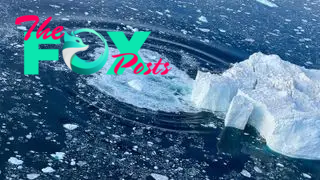Science
Earth from space: Mysterious wave ripples across 'galaxy' of icebergs in Arctic fjord
Where is it? Itilliarsuup Kangerlua fjord, Greenland [70.72910805, -50.71839266].
What's in the photo? A mysterious wave, or arc, rippling across the fjord's surface.
Which satellite took the photo? Landsat 9.
When was it taken? August 3, 2023.
This striking satellite photo captured a Mysterious arc in an ethereal, iceberg-covered fjord deep within the Arctic Circle. Researchers proposed several possible explanations for the bizarre phenomenon, but we will likely never find out for sure what caused it.
The Itilliarsuup Kangerlua fjord is part of the Uummannaq Fjord system in Western Greenland, around 460 miles (740 kilometers) north of the country's capital Nuuk. The narrow waterway, which is around 1.6 miles (2.6 km) long, was carved by two glaciers, Sisoortartukassak and Kangilleq, which are separated by a small island at the base of the fjord, according to NASA's Earth Observatory.
During the summer, the fjord's surface becomes littered with thousands of tiny iceberg fragments that have sloughed off from the glaciers, making the water look like a starscape from a deep-field telescope image when viewed from above. However, the most interesting feature in the image is a thin white arc that spans across the fjord. This arc is most likely a displacement wave that was Traveling up the fjord away from the ice masses, according to the Earth Observatory.
Related: 12 amazing images of Earth from space

The wave may have been caused by a large chunk of ice breaking off from the Kangilleq glacier and falling into the water — similar to the ripples you see when you throw a stone into a perfectly still lake.
"To me, it does look like a wave caused by a calving event," Josh Willis, an oceanographer at NASA's Jet Propulsion Laboratory, told the Earth Observatory. The "perfect shape" of the arc and orientation of the wave are similar to those of calving events observed in other glaciers, he added.
Dan Shugar,a geomorphologist at the University of Calgary, and Mike Wood, a glaciologist at Moss Landing Marine Laboratories in California, also believe the arc was the result of a calving event, according to the Earth Observatory.
-

 Science2d ago
Science2d agoInside Capitol Hill’s Latest UFO Hearings
-

 Science2d ago
Science2d agoYou Won’t Want to Miss the Leonid Meteor Shower. Here’s How and When You Can See It
-

 Science3d ago
Science3d agoHere’s What Trump’s Win Means for NASA
-

 Science6d ago
Science6d agoWhy Risky Wildfire Zones Have Been Increasing Around the World
-

 Science6d ago
Science6d agoIt’s Time to Redefine What a Megafire Is in the Climate Change Era
-

 Science1w ago
Science1w ago4 Astronauts Return to Earth After Being Delayed by Boeing’s Capsule Trouble and Hurricane Milton
-

 Science1w ago
Science1w agoThe Elegance and Awkwardness of NASA’s New Moon Suit, Designed by Axiom and Prada
-

 Science1w ago
Science1w agoSpaceX Launches Its Mega Starship Rocket. This Time, Mechanical Arms Catch It at Landing



























